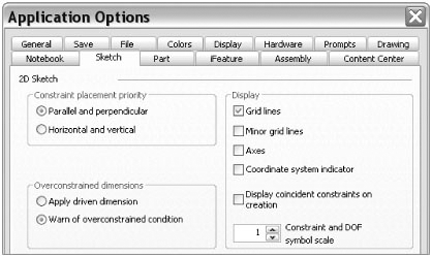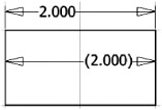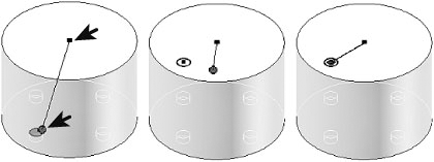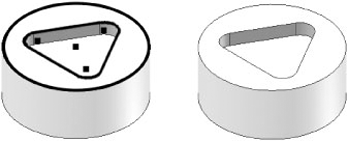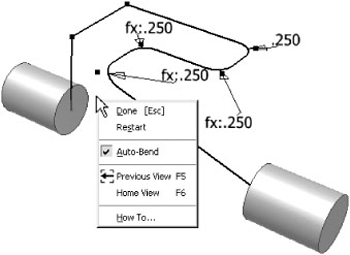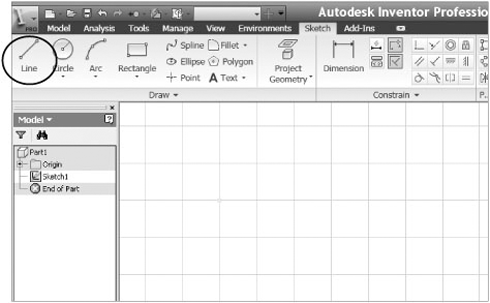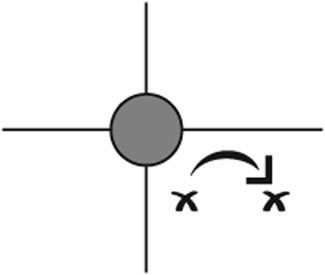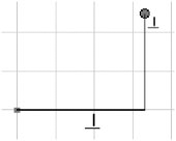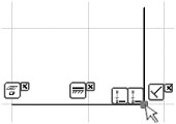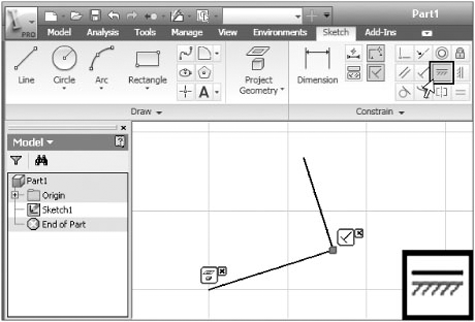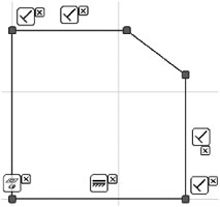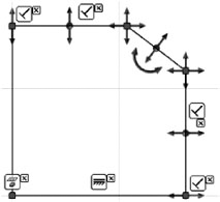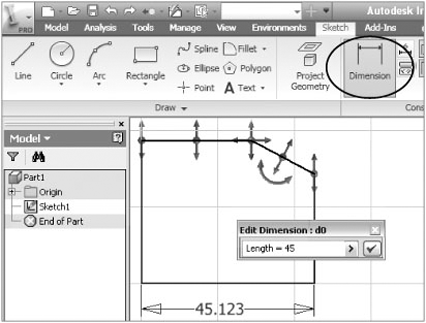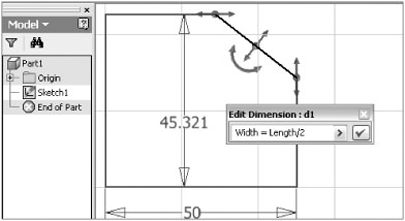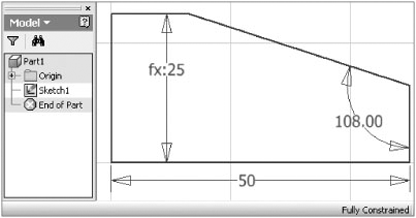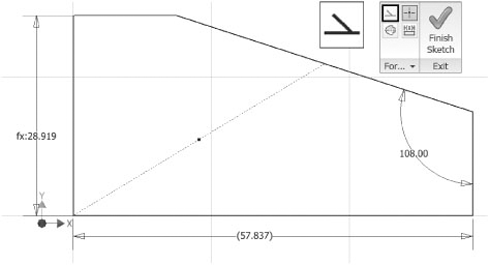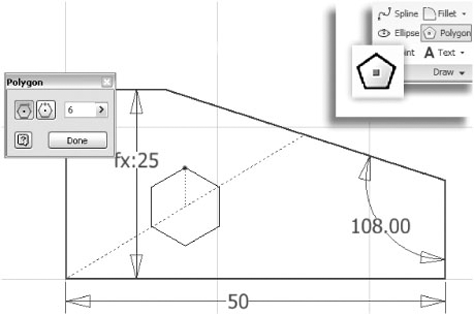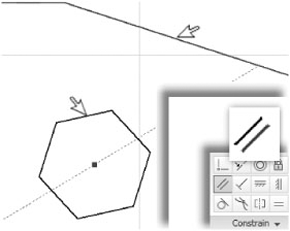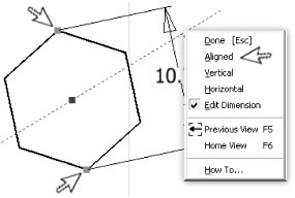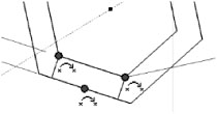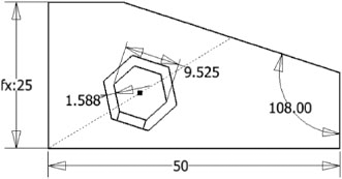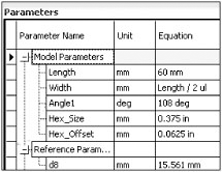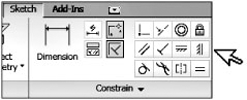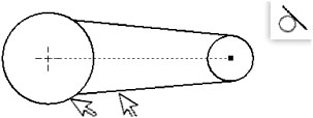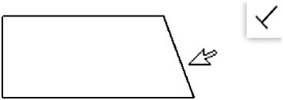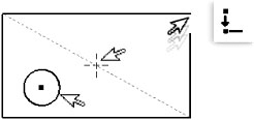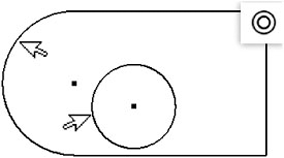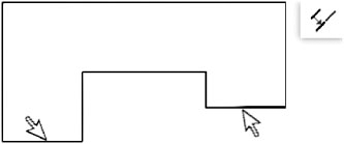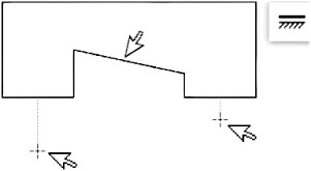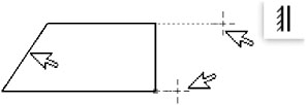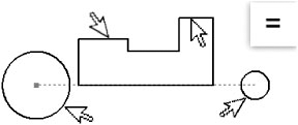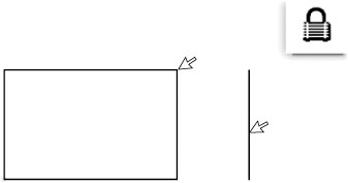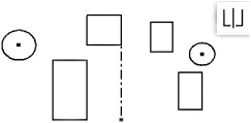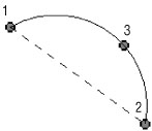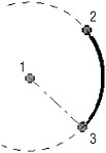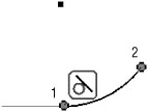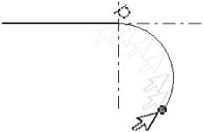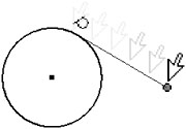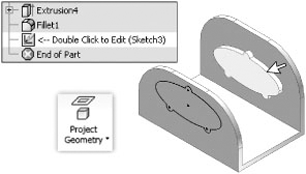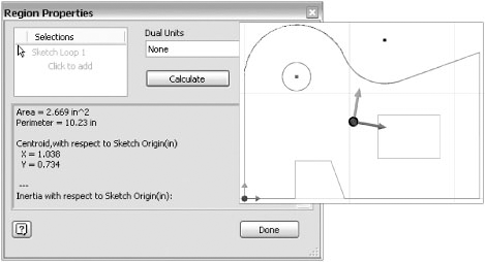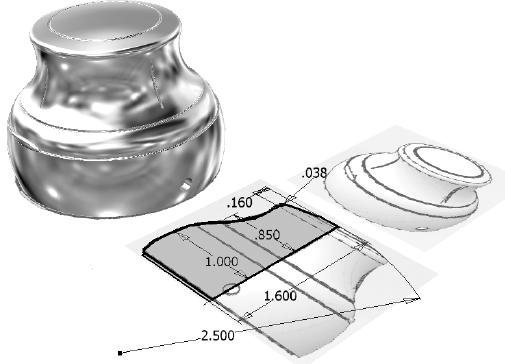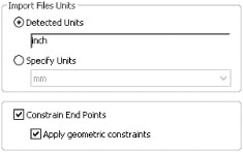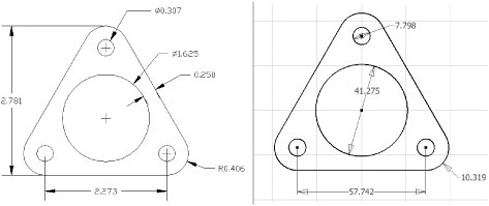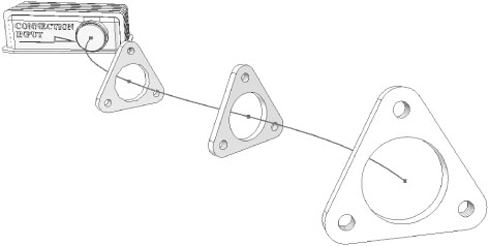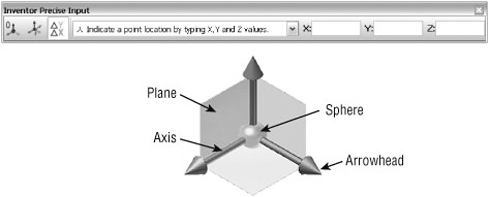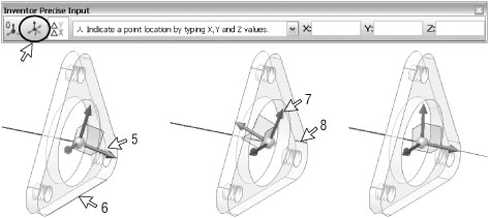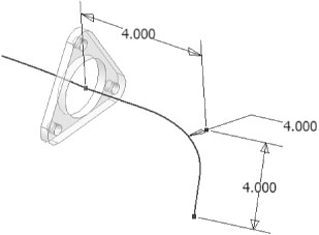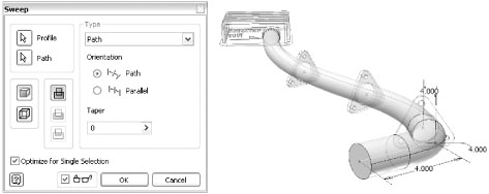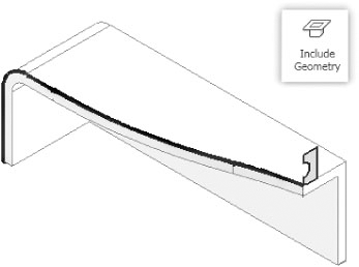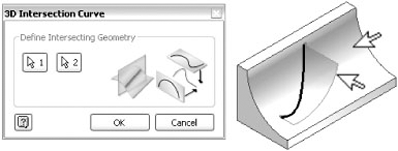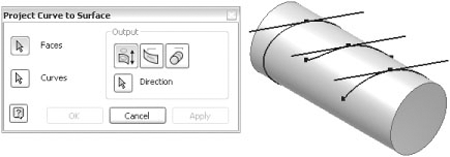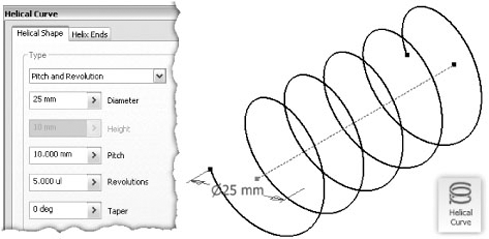This chapter will cover the principles of creating parametric sketches used in part or assembly modeling. All the skills in this chapter are based primarily on creating a single part, whether in a single-part file or in the context of an assembly file.
Autodesk Inventor utilizes two types of sketches, a 2D sketch and a 3D sketch. A 2D sketch is created on any geometry plane and is the more common of the two types. A 3D sketch is not limited to a sketch plane and can be comprised of geometry in any point in space. 3D sketches are often created from existing geometry. Both 2D and 3D sketches are controlled by two basic parameter types: dimensions and sketch constraints.
In Inventor, sketches are generally "roughed out" with basic geometry and sketch constraints first and then fully defined with dimensions that drive the geometry. The dimensions dictate the length, size, and angle of the sketch geometry. For the dimensions to do this predictably, sketch objects must know how to interact with one another. This interaction is defined by the sketch constraints. This chapter will cover how to create a part and the features of basic 2D sketches, including the tools and settings that govern their creation. Also covered is how to use AutoCAD data to create sketches and to create 3D sketches.
In this chapter, you'll learn to:
Set up options and settings for the sketch environment
Create a sketch from a part file template
Use sketch constraints to control sketch geometry
Master general sketch tools
Create sketches from AutoCAD geometry
Use 3D sketch tools
Before you jump into creating a part sketch, take a look at the options and settings Inventor provides for sketches. Options and settings in part files are located in two different areas of Inventor depending upon whether the focus of these settings affects the application (Inventor) or the document (your part file). We'll look at both application options and document options in this section.
Application options change settings for your installation of Inventor. You can adjust the application settings as follows:
From the Tools tab, click the Application Options button.
Then choose the Sketch tab, as shown in Figure 3.1.
The application options on the Sketch tab are as follows:
- The Constraint Placement Priority section
The options in this section determine the primary method of inferred constraint placement. In Inventor, your line work employs sketch constraints to tell lines, arcs, and circles how to interact with one another. Much of these constraints are placed automatically while you sketch based upon the existing geometry. This automatic placement is called constraint inference. Parallel And Perpendicular, the default setting, will look first for relationships between geometry, before looking at the coordinates of the sketch grid. Horizontal And Vertical does just the opposite. Figure 3.2 shows constraint placement with parallel and perpendicular on the left and horizontal and vertical on the right.
- The Overconstrained Dimensions area
This area controls the way redundant dimensions are handled in sketches. As an example, if you sketch a rectangle of approximately 2 inches long and then you can place a dimension on one of the horizontal lines and set the dimension to be precisely 2 inches, the rectangle will stretch horizontally to be 2 inches. But if you apply another dimension from the left vertical line to the right vertical line, Inventor will either warn you of the overconstrained situation or automatically place the dimension as a driven dimension. Figure 3.3 shows a driving dimension and driven dimension in parentheses.
- The Display area
Located in the upper-right portion of the Sketch tab, this area gives you settings for grid lines, minor grid lines, axes, and a 2D coordinate system indicator. All of these options set different visual references in the form of grid lines and coordinate indicators. You can experiment with these settings by deselecting the box next to each option and clicking the Apply button while in sketch mode. To ensure that your screen matches the illustrations in this chapter, deselect all the options in this area except for the Grid Lines box, as shown in Figure 3.1.
- The Display Coincident Constraints On Creation check box
If selected, this option displays a yellow dot at all sketch points where coincident constraints are placed when sketching. Hovering your mouse pointer over the dots displays the coincident constraint symbol, as shown on the left in Figure 3.4. If the check box is not selected, these coincident symbols are not displayed initially, as shown on the right of Figure 3.4 but can still be displayed by pressing the F8 key (Show All Constraints) while in a sketch.
- The Constraint And DOF Symbol Scale setting
This simply controls the size of the icons present when viewing sketch constraints. You can see coincident symbols on the left of Figure 3.4.
- The Spline Fit Method area
This determines the initial type of transition for a spline between fit points. Figure 3.5 shows two splines drawn with the same input points. On the left, the standard spline solution is in bold with the AutoCAD solution dashed; on the right, the standard solution is dashed with the AutoCAD solution in bold.
- Standard
Creates a spline with a smooth continuity (G3 minimum) between points. This spline type tends to overshoot at sharp transitions. Use this for Class A surfaces such as automotive design.
- AutoCAD
Creates a spline using the AutoCAD fit method (G2 minimum). This is not used for Class A surfaces.
- Minimum Energy
Sets the fit method to create a spline with smooth continuity (G3 minimum) and good curvature distribution. Multiple internal points are used between fit points, resulting in a nice heavy curvature. This can also be used for Class A surfaces, but it takes the longest to calculate and creates the largest file size.
- The Snap To Grid check box
This allows your mouse pointer to snap to a predefined grid spacing. The grid spacing is controlled per file in the document settings, as will be discussed in the coming pages.
- The Edit Dimension When Created check box
This permits immediate input of a dimension value while applying sketch dimensions. Ensure that this box is selected.
- The Autoproject Edges During Curve Creation check box
This allows you to reference geometry that exists from your sketch plane and have that geometry automatically included in your sketch. As an example, if you sketch on the top face of a part that has a hole on the bottom face, you might want to find the center of the hole to reference in your sketch, but since that hole exists on a different plane, it needs to be projected up into your current sketch before you can do so. Enabling this option allows you to "rub" your mouse over the hole and have it automatically projected into your sketch. Figure 3.6 shows a line being sketched from the middle of the cylinder to the center of a hole on the bottom face. With this option on, simply rubbing the edge of the hole will project it to the top face so that the line can be sketched to the center of the projected circle. This option can be toggled on and off in the right-click menu of most of your sketch tools such as Line, Circle, Arc, and so on.
- The Autoproject Edges For Sketch Creation And Edit check box
This automatically projects the edges of the face when you create a sketch on it. Although this can be convenient in some cases, it can also become counterproductive because it places extra line work into your sketches. This can add a level of complexity to your sketches that is not required. Figure 3.7 shows the results of selecting this option.
- The Look At Sketch Plane On Sketch Creation check box
This reorients the graphics window so that you are always looking perpendicular to the sketch plan while creating or editing a sketch.
- The Autoproject Part Origin On Sketch Create check box
This automatically projects the part's origin center point whenever a new sketch is created. The origin center point is point 0 in the X, Y, and Z directions. Projection of this point makes it easy to constrain and anchor your sketch. If this option is not selected, you are required to manually project this point.
- The Point Alignment On check box
This allows endpoints and midpoints to be inferred by displaying temporary, dotted lines to assist in lining up sketch entities. Figure 3.8 shows an endpoint being located using the Point Alignment option.
- The Auto-bend With 3D Line Creation check box
This allows corners to be automatically rounded when creating a 3D sketch. This feature can be turned on and off via the right-click menu when using the Line tool in a 3D sketch. Figure 3.9 shows two corners created without the auto-bend feature enabled and four corners created with it enabled through the right-click menu. The auto-bend radius size is set per file via the document settings.
You can save the changes you make to the application options by clicking the Export button at the bottom of the Application Options dialog box. In the resulting Save Copy As dialog box, simply specify the name of the .xml file, and click OK. You can import this .xml file at any time to restore your custom settings by using the Import button at the bottom of the Application Options dialog box.
In addition to the previous settings, which are set application-wide, there are also settings that control options per file. Document settings vary depending upon the file type you are in. For part files, you can modify the sketch settings by clicking the Document Settings icon on the Tools tab of the Ribbon while you are in an open part file. Once open, click the Sketch tab to access the following settings:
- Snap Spacing
This sets the spacing between snap points to control the snap precision when sketching in the active part or drawing. This is relevant only when using the Snap To Grid option on the Sketch tab of the Application Options dialog box. The settings for the x- and y-axes can be different.
- Grid Display
This sets the spacing of lines in the grid display for the active file.
- Line Weight Display Options
These set the options for line weight display in the sketch environment. This setting does not affect line weights in printed model sketches but merely the on-screen display.
- Auto-bend Radius
Sets the radius for 3D sketch line corners when the auto-bend feature is used.
You may want to configure the document settings in a template file and then save those settings back to that file so that they are always set. To do so, click the Inventor button, and select Save As
Now that you've explored the sketch options and settings, you will create a new part file and explore the tools used to create sketch entities. To create a part model in Inventor, you will typically start with a 2D sketch and build a base feature from that sketch.
You create new part files from an .ipt template. Once you open the .ipt template, you will automatically be in the sketch environment. In this exercise, you will use the Standard(mm).ipt file.
Click the Inventor button, and choose New

In the New File dialog box, click the Metric tab, and select the
Standard(mm).ipticon, as shown in Figure 3.10.Click OK to create a new part file based on this template.
Your screen should now show the Sketch tab set active on the Ribbon, and a sketch called Sketch1 has been created and set current in the Model browser. In the following steps you will create simple geometry using the line tool. These steps will focus on creation of 2D sketch constraints as well.
Pause your mouse pointer over the Line tool in the Sketch tab's Draw panel. (See Figure 3.11 for the location of the Line tool.)
Note the tool tip that appears, providing the tool name, keyboard shortcut (in this case L), and a brief description of the tool. If you hover the pointer over long enough, a second stage of the tool tip appears with a more detailed description of the tool.
Click the Line button to start the Line tool.
Hover your mouse pointer over the dot in center of the drawing area. This is the 0,0,0 origin point that has been automatically projected into Sketch1.
Note that when your mouse pointer moves over the dot it changes to a green dot and shows a small glyph symbol. This green dot is a snap symbol indicating that a point, endpoint, or midpoint has been located. The glyph symbol indicates that a sketch constraint is being placed. In this case, it is a coincident constraint, which ensures that the endpoint of the line will stay coincident to the projected origin point. See Figure 3.12 for reference.
Start your line on this point by clicking the dot and releasing the mouse button.
Move your mouse pointer directly to the right, and you will see another glyph indicating that a horizontal sketch constraint is being placed (see Figure 3.13 for reference). The horizontal constraint ensures that the line will stay positioned horizontally. Note that if you move your mouse pointer so that the line is being drawn at an angle, the glyph disappears.
Notice the status bar at the bottom of the screen indicating the length and angle of the line as you move the mouse pointer. Click the graphics window while the horizontal glyph is displayed to create a line roughly 45mm long. Don't worry about getting an exact length. You will set the precise length later; for now, you are just "roughing in" a general shape. Note the line continues when the first line segment is placed, and you can add more segments as required.
Move your mouse pointer straight up to add another line segment, and note another glyph appears at the mouse pointer. This is a perpendicular glyph indicating that a sketch constraint is being placed that will hold the first and second line segments perpendicular (see Figure 3.14 for reference).
Click the graphics window to create the second segment at roughly 45mm long and perpendicular to the first segment.
Right-click, and choose Done to exit the Line tool. Note that the Esc key will also exit the active tool, as indicated in the right-click menu.
You should now have a single horizontal line and a single vertical line making a backward L shape. If you made a mistake, simply use the Undo icon at the top of the screen (or press Ctrl+Z) to undo and try again.
The glyphs you were observing while creating the line segments were indicators that Inventor was placing sketch constraints automatically as you were sketching the lines. By default the sketch constraints have their visibility turned off. If you want to see the sketch constraints that are present and how they work, continue with the following steps:
Right-click anywhere in the graphics window other than on the lines, and choose Show All Constraints (or press F8 on the keyboard). You will now see the sketch constraint icons for the constraints that were inferred as you created the line segments.
Hover your mouse pointer over the perpendicular constraint at the corner of the two line segments to see both lines highlighted, which indicates that these are the objects involved in this particular constraint definition.
Hover your mouse pointer over the yellow dot at the corner of the two line segments, and you will see two coincident constraints appear, as shown in Figure 3.15. Hovering your mouse pointer over each will highlight the line to which they belong. Coincident constraints are initially "rolled up" in this way because they are generally very numerous and tend to clutter the sketch when all constraints are shown.
Click the X on any of the constraints to hide just that particular constraint.
Next right-click anywhere in the graphics area other than on the lines, and choose Hide All Constraints (or press F9 on the keyboard). You can toggle the visibility of all sketch constraints on and off as needed in order to determine how sketch entities are constrained together.
Let up on the corner, select the corner point of the two line segments, and hold down and drag around in a circle. You will notice that the horizontal line will stretch as required but will always remain horizontal; the vertical line will always remain perpendicular.
Select the uppermost endpoint of the vertical line, and drag around in a circular motion as well. Note the two lines will adjust lengths as permitted but will always honor the sketch constraints that they have placed on them.
Let up on the end of the line, and press F8 to show the constraints again.
Right-click the horizontal constraint.
Choose Delete to remove this constraint.
Press F9 to hide the constraints again.
Click the corner of the lines, and hold down and drag around in a circular motion. Note that the lines will stretch and adjust orientation but will maintain their perpendicular and coincident relationships.
At this point, the constraints present in your sketch were all inferred (placed automatically). Letting Inventor infer sketch constraints is the quickest and often most desirable way to place sketch constraints; however, sometimes you'll need to constrain sketch elements manually. To do so, you can use the constraint tools found in the Constrain panel of the Ribbon.
To place the horizontal constraint back on the line from which you removed it, follow these steps:
Go to the Constrain panel of the Ribbon, and click the Horizontal Constraints icon, as shown in Figure 3.16.
Click the first line segment you sketched to set it back to horizontal.
Use the Line tool to add three more line segments to the sketch to complete the shape, as shown in Figure 3.17. Pay attention to the cursor glyphs as you sketch, and do not be concerned with the precise lengths of the lines or the angle of the diagonal line.
Typically your goal is to create fully constrained sketches so that no aspect of the sketch can be changed without deliberate action. To examine your sketch for under-constrained elements, you can use the Degrees of Freedom (DOF) tool:
To view the DOF arrows for your sketch entities, right-click anywhere in the graphics area that is not on a sketch object, and choose Show All Degrees Of Freedom. Your sketch should resemble Figure 3.18.
Notice the arrow indicators showing the DOF for each sketched line.
Drag an endpoint, and you will see the sketch lines will drag only in a direction or orientation that follows the DOF arrows. If your sketch becomes distorted in an undesirable way, use the Undo icon at the top of the screen or press Ctrl+Z to set it back as it was.
To toggle the DOF visibility back off, right-click again, and choose Hide All Degrees Of Freedom.
Note that you can right-click an individual sketch object or a selection set of sketch objects and choose Display Degrees Of Freedom to show the DOF for just those selected objects.
Right-click and choose Show All Degrees of Freedom again to have these displayed for reference in the next steps.
To work toward your goal of a fully constrained sketch, you will now add dimensions to lock down lengths, angles, and so on. Adding dimensions will remove degrees of freedom from your sketch objects and help you define the intent of your design. You will use the General Dimension tool to place dimensions on your sketch. Note that although the tool is called General Dimension, the button simply reads Dimension.
On the Sketch tab of the Ribbon, click the Dimension icon in the Constrain panel, as indicated in Figure 3.19.
In the graphics area, click the bottom horizontal line, and drag down to display the dimension.
Click below the line to place the dimension, and you should see an Edit Dimension box, as shown in Figure 3.19. If you do not see the Edit Dimension box, you can right-click anywhere in the blank space of the graphics area and click Edit Dimension to ensure that this box shows up after placing each dimension. Then simply click the dimension to open this input box.
In the Edit dialog box, type Length = 45. Because you are working in a millimeter-based part file, the units are assumed to be 45mm, and Inventor will add the mm automatically.
Notice the Edit Dimension box caption reads something such as d0. This indicates that this dimension parameter is named d0. Initially, Inventor names the first dimension used in the file d0, the next is named d1, and so on. By entering Length = 45, you are renaming the dimension from d0 to Length and changing this length value from the sketched value to a precise value of 45mm. You are not required to rename your dimensions, but it is good practice to name any that you intend to reference later.
Click the green arrow in the Edit Dimension box, or press the Enter key to set the dimension value. Take note that the dimension "drives" the sketch to be 45mm long. Also notice that some of the DOF arrows have been removed.
Click the 45mm dimension to edit it. Notice that the Edit Dimension box caption now reads Length and the value now reads 45mm.
Change the value to 50mm, and click the green arrow.
Next click the bottom horizontal line again and drag up, but do not click to place the dimension. You will see the same horizontal dimension displayed.
Click the top horizontal line, and drag down, and you will see the dimension change from the horizontal dimension evaluation the length of the bottom line to a vertical dimension evaluating the distance between the top and bottom lines.
Click the graphics window to place the dimension.
Enter Width=
Click the 50mm dimension you placed in the previous steps. Notice that clicking one dimension while editing another will create a reference between the two.
Complete the formula to read Width = Length/2, as shown in Figure 3.20.
Click the green arrow or press the Enter key to set the dimension value. Observe that the Width dimension is evaluated at half the Length dimension and that it displays an fx: before the value to denote that there is a function used to evaluate this dimension. Also notice that more DOF arrows have been removed as you have further defined the sketch.
If your sketch has become a bit skewed, exit the Dimension tool by right-clicking and choosing Done (or by pressing the Esc key).
Click the top endpoint of the vertical line to the right, and drag it so that the profile general shape is restored.
On the Sketch tab of the Ribbon, click the Dimension icon in the Constrain panel, or just press D on the keyboard to start the Dimension tool again.
Click the vertical line to the right, and then click the diagonal line. Take care to click the lines and not the endpoints of the lines, because doing do will result in a different dimension type.
You will be presented with an edit box for an angle dimension. Enter Angle1 = 108, and click the green check mark.
Lastly, on the Sketch tab of the Ribbon, click the Equal button in the Constrain panel to place an equal constraint. Select the top horizontal line and the vertical line on the right to set those two lines equal.
Your sketch is now fully constrained and should resemble Figure 3.21.
A fully constrained sketch is evident by taking note of the following:
All the DOF arrows are now gone.
You will see Fully Constrained in the status bar at the bottom right of the screen.
Your sketch lines will have turned a different color than they were originally, before becoming constrained.
At this point, you may have seen a save reminder balloon in the lower-right corner of the screen. It is always good practice to save often when working in any application. To save a part file, you must first exit the sketch and then save:
On the Ribbon's Sketch tab, click Finish Sketch in the Exit panel. Or right-click in the graphics area and choose Finish Sketch from the menu.
Click the Inventor button, and then select Save.
Select the Chapter3 folder, and name the file
mi_001.
You should be aware of the all the save options you have and how they differ. These can all be accessed by clicking the Inventor button and choosing Save or Save As from the Application menu. Here's a list:
- Save
Choosing this option saves the active document contents to the file specified in the window title, and the file remains open.
- Save All
Choosing this option saves all open document contents to the file specified in the window title, and the files remain open.
- Save As
Choosing this option saves the active document contents to the file specified in the Save As dialog box. The original document is closed, and the newly saved file is opened. The contents of the original file are unchanged.
- Save Copy As
Choosing this option saves a copy of the active file as specified in the Save Copy As dialog box, and the original file remains open.
- Save Copy As Template
Choosing this option saves a copy of the active file as a template to the template folder, and the original file remains open.
To save a file, you are required to exit the sketch. To continue making edits to the sketch once saved, you need to set the sketch active for edits. Here's how to activate the sketch:
Locate Sketch1 in the Model browser to the left of your screen, and either right-click and choose Edit Sketch or double-click the browser sketch icon.
Notice that the Sketch node listed in the browser consists of the sketch icon and the sketch name. Clicking the sketch name once and then again (don't double-click) allows you to rename the sketch. Therefore, you may want to develop a habit of double-clicking the sketch icon rather than the sketch name to set a sketch active for edits.
Look at the browser and notice that the rest of the browser nodes are grayed out and Sketch1 is highlighted, letting you know that the sketch is active for editing. You'll also notice that the sketch tools are available.
Now that the sketch is active, you will add more geometry and dimensions to further explore the sketch tools. You'll start by sketching a line and then converting that line to a construction line. Construction geometry is often used to help locate and constrain normal sketch geometry.
The primary difference between construction geometry and standard geometry is that construction geometry is filtered out of profile calculations. In other words, if you have a part profile consisting of a rectangle and you run a construction line down the middle of it, resulting in two halves of the original profile, Inventor will ignore the construction line and see only one profile when you go to create a solid part from the sketch. To create a construction line in your sketch, follow these steps:
Click the Line tool in the Sketch tab's Draw panel. (Recall that you can access the Line tool by pressing the L key on the keyboard as well.)
Start the line at the bottom-left corner of the profile, keeping an eye on your mouse pointer to ensure that you see the green dot (indicating the endpoint) and the constraint glyph (indicating a coincident constraint is being inferred).
Set the second point of the line on the midpoint of the diagonal line. Again, you should see a green dot and a coincident glyph, as shown in Figure 3.22.
Right-click and choose Done to exit the Line tool.
Select the new diagonal line you just created.
On the Sketch tab (to the far right), click the Construction icon in the Format panel, as shown in Figure 3.23.
Notice the line has changed from a solid line to an orange dashed line, indicating that it is now a construction line.
Next you will need to add a polygon to the midpoint of the construction line and manually place a constraint to position it in place. You will then need to place a dimension to size it:
In the Sketch tab's the Draw panel, click the Polygon tool.
Select the midpoint of the diagonal construction line, keeping an eye on your mouse pointer for the green midpoint dot and the coincident glyph.
Leave the polygon settings at the defaults, and drag out the size and orientation to roughly match Figure 3.24.
In the Sketch tab's Constrain panel, click the Parallel constraint icon.
Choose any of the flats on the polygon and the diagonal profile line as shown in Figure 3.25 to make the two lines parallel.
In the Sketch tab's Constrain panel, click the Dimension tool.
On the polygon, click two opposing points as shown in Figure 3.26 to create a dimension between the two points.
Pull your mouse pointer to the side to preview the dimension. Notice that the orientation wants to be horizontal or vertical depending upon the location of your mouse pointer.
Right-click and choose Aligned to force the aligned solution for this particular dimension.
Click the graphics window to place the dimension.
Enter Hex_Size = 0.375 in.
Click the green arrow or press the Enter key to set the dimension value. Notice that although you entered an empirical unit of inches, Inventor converted the value automatically to the file default of millimeters. This is a powerful function that allows you to use dimension inputs to do conversion calculations on the fly.
You will now use the Offset and Three Point Rectangle tools to create more sketch geometry:
Before selecting any geometry, right-click anywhere that is not on the sketch geometry.
Ensure that the Loop Select and Constrain Offset options are both selected.
Selecting Loop Select means that all joined geometry will be selected as a loop. With this option toggled off, individual line or curve segments are selected.
Selecting Constrain Offset means the new geometry is constrained to be equidistant to the original. If you turn this option off, the new geometry is created unconstrained to the original.
Click the polygon, and drag to the outside.
Click the graphics window to set the offset distance.
Right-click and choose Done (or press the Esc key) to exit the Offset tool.
In the Sketch tab's Constrain panel, click the Dimension tool (or press D on the keyboard)
To dimension the offset, select an edge of the original polygon, and then select the corresponding edge on the new offset polygon.
Drag the dimension out from the center of the polygon, and place it anywhere.
Enter Hex_Offset = 1/16", and click the green check mark. The result should appear similar to Figure 3.27.
In the Sketch tab's Draw panel, click the Rectangle flyout, and choose Rectangle Three Point, as shown in Figure 3.28.
Create the rectangle using the three points shown in Figure 3.29. Make certain that you are seeing the green snap dots and coincident constraints glyphs at each point.
Right-click, and choose Done.
You might find the Split tool is actually what you want. Split will divide a line into separate segments without removing them. And it will also maintain sketch constraints. You can find the Split tool in the Sketch tab's Modify panel as well. Hover your mouse pointer over it for a moment and you will get a dynamic tool tip showing you how it works. This completes the creation of most of your sketch objects in this exercise. Your sketch should resemble Figure 3.30.
Now let's take a look at creating driven dimensions and editing the parameters you just created through the Parameters dialog box. Because dimensions define the parameters of your design, you can use them to control the design intent. Other times you may want to place a dimension that does not drive the design but instead is driven by other parameters. In those cases, such dimensions are called driven dimensions.
Unlike Inventor's standard parametric dimensions, driven dimensions do not change the geometry but instead change when the geometry changes. Driven dimensions are created either by placing a dimension on already defined geometry or by explicitly making them driven.
Follow these steps to explore driven dimensions:
Double-click the 50mm Length dimension.
Replace the value of 50 with 60, and press the Enter key.
Take note that the vertical dimension retains the intent of your design and remains at half the Length value.
In the Sketch tab's Constrain panel, click the Dimension tool (or press D on the keyboard).
Select the vertical line on the right of the sketch, and click the graphics window to place the dimension.
You will be presented with a dialog box warning you that this dimension will overconstrain the sketch. Click Accept to place the dimension as a driven dimension.
Notice that the dimension is created in parentheses, denoting that it is driven by other parameters, and therefore is considered a reference parameter. Driven dimensions are useful in capturing dimensions for use in the calculations of other features.
Next switch from the Sketch tab to the Manage tab on the Ribbon.
Click the Parameters tool. This will open the Parameter dialog box listing all the dimensions you've created in this part as parameters, as shown in Figure 3.31.
Change the Length value from 60mm back to 50mm.
Click Done to return to the sketch. Notice the dimensions have not updated.
To update the dimension, go to the Quick Access bar at the top left of the screen, and click the Update button, as shown in Figure 3.32. Notice that the sketch dimensions update and the Update button becomes grayed out letting you know that file you are working with does not require updates at this time.
You'll notice that because of the intelligence you've built into the sketch, when you modify and update the Length dimension (parameter) value, the dependant values change as well.
Next, you'll change a driving dimension to a driven dimension and a driven to a driving. By doing this, you can modify the intent of your design and change which parameter is a key input.
Click the 50mm Length dimension.
In the Sketch tab's Format panel, click the Driven Dimension tool. Notice that the Length dimension is now set in parentheses, indicating that it is now driven rather than driving.
Double-click any blank area in the graphics window to unselect the previous dimension.
Select the vertical dimension that is in parentheses.
Click the Driven Dimension tool again to toggle this dimension from a driven to a driving dimension.
Double-click the vertical dimension to edit its value.
Enter Vertical_Leg = 15mm, and click the green check mark. Notice that the Vertical_Leg parameter now drives the Length parameter, which drives the Width dimension. You should be beginning to see the power of parametric design.
You can close this file without saving changes.
Now that you've been introduced to the basics of creating a parametric sketch, take a more in-depth look at these tools in the next sections.
In this section, you'll take a closer look at each of the available sketch constraints. As you proceed, it may occur to you that you could use some sketch constraints in place of the one suggested in the exercise steps. Be aware that as you create sketch constraints, there are often multiple solutions to get the same result.
In the following exercises, you will be opening a series of part files, setting the sketch within active for edits, and applying different sketch constraints. Each of these files demonstrates the function of a different type of sketch constraint. All of these files contain a sketch called <-- Double Click to Edit (Sketch 1). You will edit the sketch in each file and apply the appropriate sketch from the Constrain Panel of the Sketch tab, as shown in Figure 3.33.
The tangent constraint places one object or edge in a tangency to another object or edge. Objects can be tangent to another even if they do not share a physical point. Follow these steps to explore the tangent constraint:
Click the Inventor button, and choose Open (or press Ctrl+O on the keyboard).
Browse for the file named
mi_3h_001.iptlocated in the Chapter 3 directory of the Mastering Inventor 2010 folder, and click Open.In the Model browser, double-click Sketch1 to edit it. Or, right-click it, and choose Edit Sketch.
Press the F8 key to show all the constraints. Note there is no tangent constraint between the large circle and the lines.
In the Sketch tab's Constrain panel, click the Tangent button. Click the line and circle, as shown in Figure 3.34.
Repeat to set a tangent constraint on the top line and the same circle.
Right-click, and choose Done.
Press the F8 key to show all the constraints, and note the new tangent constraints.
You can exit the file without saving once you are finished.
The perpendicular constraint constrains objects or edges to be always perpendicular. Follow these steps to explore the perpendicular constraint:
From the Get Started tab, select the Open button.
Browse for the file named
mi_3h_002.iptlocated in the Chapter 3 directory of the Mastering Inventor 2010 folder, and click Open.In the Model browser, double-click Sketch1 to edit it. Or, right-click it, and choose Edit Sketch.
In the Sketch tab's Constrain panel, click the Perpendicular button.
Click the line as shown in Figure 3.35, and then select either of the horizontal lines.
Right-click, and choose Done.
Press the F8 key to show all the constraints, noting the new perpendicular constraint.
You can exit the file without saving once you are finished.
The parallel constraint constrains objects or edges to be always parallel. Follow these steps to explore the parallel constraint:
From the Get Started tab, select the Open button.
Browse for the file named
mi_3h_003.iptlocated in the Chapter 3 directory of the Mastering Inventor 2010 folder, and click Open.In the Model browser, double-click Sketch1 to edit it. Or, right-click it, and choose Edit Sketch.
In the Sketch tab's Constrain panel, click the Parallel button.
Click the line as shown in Figure 3.36, and then select the lower horizontal line.
Right-click, and choose Done.
Press the F8 key to show all the constraints, and note the new parallel constraint.
You can exit the file without saving once you are finished.
The coincident constraint places objects or points in contact with another object. Follow these steps to explore the coincident constraint:
From the Get Started tab, select the Open button.
Browse for the file named
mi_3h_004.iptlocated in the Chapter 3 directory of the Mastering Inventor 2010 folder, and click Open.In the Model browser, double-click Sketch1 to edit it. Or, right-click it, and choose Edit Sketch.
In the Sketch tab's Constrain panel, click the Coincident button.
Click the center of the circle and then on the center point, as shown in Figure 3.37.
Right-click, and choose Done.
Next, click the endpoint of the vertical line at the top-right corner of the rectangular shape, and hold down as you drag to close the profile. Note that a coincident constraint is placed.
Press the F8 key to show all the constraints, and note the new coincident constraints, as shown by the yellow dots.
Hover your mouse pointer over the dots to see coincident constraint symbols.
You can exit the file without saving once you are finished.
The concentric constraint places arcs and circles so that they share the same center point. Follow these steps to explore the concentric constraint:
From the Get Started tab, select the Open button.
Browse for the file named
mi_3h_005.iptlocated in the Chapter 3 directory of the Mastering Inventor 2010 folder, and click Open.In the Model browser, double-click Sketch1 to edit it. Or, right-click it, and choose Edit Sketch.
In the Sketch tab's Constrain panel, click the Concentric button.
Click the edge of the circle and then the arc, as shown in Figure 3.38.
Right-click, and choose Done.
Press the F8 key to show all the constraints, and note the new concentric constraint.
The collinear constraint lines up a line object or ellipse axis on the same line as another line object or ellipse axis. Follow these steps to explore the collinear constraint:
From the Get Started tab, select the Open button.
Browse for the file named
mi_3h_006.iptlocated in the Chapter 3 directory of the Mastering Inventor 2010 folder, and click Open.In the Model browser, double-click Sketch1 to edit it. Or, right-click it, and choose Edit Sketch.
In the Sketch tab's Constrain panel, click the Collinear icon.
Click the lines as shown in Figure 3.39.
Right-click, and choose Done.
Press the F8 key to show all the constraints, and note the new collinear constraint.
You can exit the file without saving once you are finished.
The horizontal constraint makes an object line up parallel to the x-axis. Two points may also line up horizontally. Follow these steps to explore the horizontal constraint:
From the Get Started tab, select the Open button.
Browse for the file named
mi_3h_007.iptlocated in the Chapter 3 directory of the Mastering Inventor 2010 folder, and click Open.In the Model browser, double-click Sketch1 to edit it. Or, right-click it, and choose Edit Sketch.
In the Sketch tab's Constrain panel, click the Horizontal button.
Click the line as shown in Figure 3.40, noting the new horizontal alignment.
Next click both of the points as indicated in Figure 3.40, noting that they will line up horizontally.
Right-click, and choose Done.
Press the F8 key to show all the constraints, and note the new horizontal constraints.
You can exit the file without saving once you are finished.
The vertical constraint makes an object line up parallel to the y-axis. Two points may also line up vertically. Follow these steps to explore the vertical constraint:
From the Get Started tab, select the Open button.
Browse for the file named
mi_3h_008.iptlocated in the Chapter 3 directory of the Mastering Inventor 2010 folder, and click Open.In the Model browser, double-click Sketch1 to edit it. Or, right-click it, and choose Edit Sketch.
In the Sketch tab's Constrain panel, click the Vertical button.
Click the line as shown in Figure 3.41, noting the new vertical alignment.
Next click both of the points as indicated in Figure 3.41, noting that they will line up vertically.
Right-click, and choose Done.
Press the F8 key to show all the constraints, and note the new vertical constraints.
You can exit the file without saving once you are finished.
The equal constraint makes two objects equal in length or radius. Follow these steps to explore the equal constraint:
From the Get Started tab, select the Open button.
Browse for the file named
mi_3h_009.iptlocated in the Chapter 3 directory of the Mastering Inventor 2010 folder, and click Open.In the Model browser, double-click Sketch1 to edit it. Or, right-click it, and choose Edit Sketch.
In the Sketch tab's Constrain panel, click the Equal button.
Click the two circles as shown in Figure 3.42, and notice that they become equal.
Click the lines as indicated in Figure 3.42, noting that they too will become equal. You can make two of the vertical lines equal if you'd like as well.
Right-click, and choose Done.
Press the F8 key to show all the constraints, and note the new equal constraints.
You can exit the file without saving once you are finished.
The fix constraint anchors any geometry or point in place within the part sketch. You should use this constraint sparingly. Follow these steps to explore the fix constraint:
From the Get Started tab, select the Open button.
Browse for the file named
mi_3h_010.iptlocated in the Chapter 3 directory of the Mastering Inventor 2010 folder, and click Open.In the Model browser, double-click Sketch1 to edit it. Or, right-click it, and choose Edit Sketch.
Drag the corner as indicated in Figure 3.43, and notice that it may be repositioned freely.
In the Sketch tab's Constrain panel, click the Fix button.
Click the same corner as before.
Right-click, and choose Done.
Drag the corner again, and notice that it is now fixed to that position.
Next apply another fixed constraint to the vertical line next to the rectangle, and be sure to click the line rather than the endpoint.
Right-click and choose Done to exit the constraint tool, and then drag either endpoint of the line. While the line position is fixed, the endpoints are still free to change.
Press the F8 key to show all the constraints, and note the new fix constraints.
You can exit the file without saving once you are finished.
The symmetric constraint creates a "mirror" constraint between two similar objects. This constraint relies upon a line to serve as a centerline about which objects are to be symmetrical. You need specify the centerline only once during the command cycle. Follow these steps to explore the symmetric constraint:
From the Get Started tab, select the Open button.
Browse for the file named
mi_3h_011.iptlocated in the Chapter 3 directory of the Mastering Inventor 2010 folder, and click Open.In the Model browser, double-click Sketch1 to edit it. Or, right-click it, and choose Edit Sketch.
In the Sketch tab's Constrain panel, click the Symmetric button, as indicated in Figure 3.44.
Click the circle on the left, and then click the circle on the right.
Next click the centerline, and observe that the circles become symmetric.
Continue by clicking a line on the square on the left side of the sketch.
Click the corresponding line on the rectangle on the right. Notice that this time you did not need to select the centerline. When using the symmetric constraint, you need only to establish the centerline once.
Continue making the sketch symmetric by selecting lines on the left of the sketch and then selecting the corresponding line on the right side.
Right-click and choose Done when the sketch is symmetric.
Press the F8 key to show all the constraints; note the new symmetric constraints.
You can exit the file without saving once you are finished.
The smooth constraint creates a continuous curvature (G2) condition between a spline and another sketch object, such as a line, arc, or spline. The G2 condition brings the curve out past the tangency point to create a smooth transition from one curve into the next. Follow these steps to explore the smooth constraint:
From the Get Started tab, select the Open button.
Browse for the file named
mi_3h_012.iptlocated in the Chapter 3 directory of the Mastering Inventor 2010 folder, and click Open.In the Model browser, double-click Sketch1 to edit it. Or, right-click it, and choose Edit Sketch.
In the Sketch tab's Constrain panel, click the Smooth button.
Click the spline and arc as indicated in Figure 3.45.
Right-click, and choose Done.
Press the F8 key to show all the constraints; note the new smooth constraint.
You can exit the file without saving once you are finished.
Many tools are available in the sketch environment, each used to draw different types of geometry or modify geometry in a different way. Many of these are covered in the following pages, but as a reminder, if you hover your mouse pointer over the tool and then pause, you will see a tool tip appear; hover a bit longer, and a larger, more informative tool tip will appear. These progressive tool tips are a great help when attempting to use tools that you don't often use and need a helpful hint remembering what they do and how they do it.
You can create sketch arcs by using one of three arc tools available in Inventor's sketch environment. All three arc types are available in a drop-down menu in the Sketch tab's Draw panel. Once placed, the three arcs behave the same; it is simply the manner in which they are created that differentiates them.
A three-point arc is an arc defined by two endpoints and a point on the arc. The first click sets the first endpoint, the second sets the other endpoint, and the third point sets the direction and radius of the arc, as shown in Figure 3.46.
A center point arc is an arc defined by a center point and two endpoints. The first click sets the center point, the second sets the radius and start point, and the third point sets the endpoint and/or arc length, as shown in Figure 3.47.
A tangent arc is an arc from the endpoint of an existing curve. The first click must be on the endpoint of an existing curve and sets a tangent constraint on the endpoint. The second point sets the end of the tangent arc, as shown in Figure 3.48.
Additionally, you can create arc segments while using the Line tool, as illustrated in Figure 3.49.
To do so, follow these steps:
From the Get Started tab, select the Open button.
Browse for the file named
mi_3h_013.iptlocated in the Chapter 3 directory of the Mastering Inventor 2010 folder, and click Open. The goal here is to re-create the oblong shape already present in the sketch.In the Model browser, double-click Sketch1 to edit it. Or, right-click, and choose Edit Sketch.
In the Sketch tab's Draw panel, click the Line icon.
Click the projected origin point as the start point of the line, and then release the mouse button. This is the small dot located at 0,0 of the sketch.
Next pull your mouse pointer to the right, ensuring that you see a horizontal or parallel glyph, indicating that your line is horizontal.
Click the screen to set the second point of the line, and then release the mouse button.
Now to sketch an arc without exiting the Line tool, click and hold the endpoint you just created, and then (still holding down on the mouse button) drag your mouse pointer out to preview the arc. If the arc previews in the wrong direction, simply return your mouse pointer to the endpoint and try again. It may be helpful to "trace" the guideline cross and exaggerate the arc size to get the direction established and then bring your mouse pointer back in to get the size you want.
Release the mouse button to end the arc and continue the Line tool.
Continue creating line/arc segments, or right-click and choose Done to exit the Line tool. Practice this a few times, and you'll have it mastered in a short time.
When adding tangent line segments to a circle or arc, you can apply the tangent constraints automatically. To do so, start the Line tool, and click and hold on the circle or arc on which you intend to create the tangent line. You will see a tangent glyph. You can drag the line segment out to the length and direction desired. Figure 3.50 illustrates this technique.
You can use the Point/Center Point tool, found in the Sketch tab's Draw panel, to create center marks for locating hole centers and specific coordinate points. Center points are used by the Hole and Sheet Metal Punch tools in the modeling environment to automatically locate hole centers. Points, or sketch points as they are often called, are initially ignored by the Hole and Punch tools but can be manually selected for use. Another key difference between the two point types is that sketch points are deleted when the associated geometry is deleted. Center points are not.
You can change the center point to sketch points, or vice versa, by selecting the point and clicking the Center Point button on the Format menu of the Sketch tab, as shown in Figure 3.51.
When creating a sketch on the face of existing geometry or a work plane, you can project existing points and edges into the sketch by using the Project Geometry tool found in the Sketch tab's Draw panel. To take a quick look at this functionality, follow these steps:
From the Get Started tab, select the Open button.
Browse for the file named
mi_3r_001.iptlocated in the Chapter 3 directory of the Mastering Inventor 2010 folder, and click Open.In the Model browser, double-click Sketch1 to edit it. Or, right-click, and choose Edit Sketch.
In the Sketch tab's Draw panel, click the Project Geometry icon.
Click the edges of the red oval-shaped profile.
When you have the complete profile projected into the sketch as shown in Figure 3.52, click the Finish Sketch button.
You can close the file without saving changes.
In this section, you'll take a look at more dimension tools and settings to help you master this very important part of sketch creation.
It is important to understand that you get different results from the Dimension tool depending upon what geometry is selected or in what order it is selected. Here are the dimension types you can place with the General Dimension tool:
Linear dimension from one object.
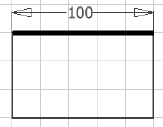
Linear dimension between two objects.
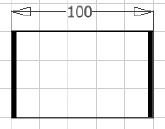
Aligned dimension between two objects: select the objects and right-click to choose the Aligned solution.
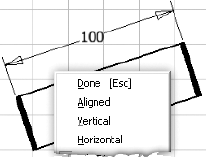
Angular dimension between two edges.

Angular dimension between three points.
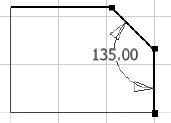
Dimensions to circles or arcs: select the object then right-click to switch between diameter or radius solutions for either arcs or circles.
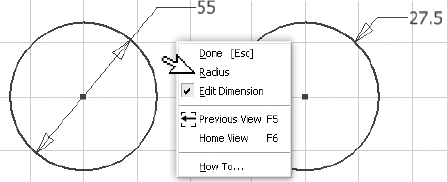
Dimension to the center of arcs and circles: select the first element of the dimension and then click anywhere on the arc or circle. Note the linear glyph indicating the linear solution you will get.
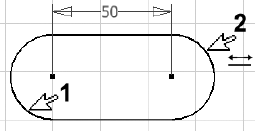
Dimension to the tangent of arcs and circles: select the first element of the dimension, and then click the tangent when you see the tangent glyph appear.
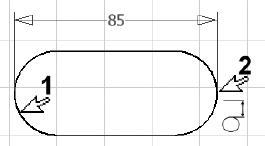
In addition to the General Dimension tool, Inventor has an Automatic Dimension tool. It is generally poor practice to use the Automatic Dimension tool to apply all dimensions to your sketches because it will do so in an illogical way. However, you can benefit from this tool by placing the dimensions that define the intent of your design with the General Dimension tool and then allowing the Automatic Dimension tool to place the remaining dimensions to fully constrain the sketch.
To take a look at the Automatic Dimension tool in action, follow these steps:
From the Get Started tab, select the Open button.
Browse for the file named
mi_3r_002.iptlocated in the Chapter 3 directory of the Mastering Inventor 2010 folder, and click Open.In the Model browser, locate Sketch1, and double-click to edit or right-click and choose Edit Sketch.
In the Sketch tab's Constrain panel, click the Automatic Dimension icon. Notice that the Auto Dimension dialog box shows the number of dimensions required to fully constrain the sketch.
Accept the default settings to add both dimensions and constraints.
With the Curves button enabled, select all of the geometry in the sketch.
Click Apply to add dimensions to the selected geometry.
When finished, click Done.
You can close the file without saving changes.
Note that you can also use the Automatic Dimension tool to apply just sketch constraints by deselecting the Dimensions check box.
You can create centerlines in sketches by either creating a regular line and then changing it to a centerline, or by changing the line type to centerline first and then creating the line. Dimensioning to a centerline gives you a diametric solution by default, but you can opt for a linear solution by right-clicking and deselecting Linear Diameter, as shown in Figure 3.53. In the following lists, you will find the steps for both methods of centerline creation, as well as how to change the solution when dimensioning to a centerline.
To change to centerline line type before creating sketch geometry, follow these steps:
Ensure the sketch is active for editing by double-clicking it or right-clicking and choosing Edit Sketch.
On the Sketch tab, click the Centerline icon in the Format panel.
Now use the Line tool to sketch lines as you would normally. Note that the Centerline icon stays pushed in (On) until you click it again.
To change an existing line to be a centerline, follow these steps:
To create a dimension to a centerline, follow these steps:
Ensure the sketch is active for editing by double-clicking it or by right-clicking and choosing Edit Sketch.
On the Sketch tab, click the Dimension icon in the Draw panel.
Select an object to the side of the centerline.
Click the centerline. Note the diametric diameter.
Right-click, and note the Linear Diameter option.
Place the dimension on the screen.
You can gather measurements from your model without placing a dimension by using the Measure tools. You can access these tools from the Tools tab or by right-clicking any empty place in the graphics area of the screen and choosing Measure from the context menu. When using the Tools tab, you can click the drop-down on the Measure panel to reveal the Region Measure tool. The measurement tools include the following:
- Measure Distance
Measures the length lines and arcs, the distance between points, and the radius or diameter of a circle.
- Measure Angle
Measures the angle between two lines or points.
- Measure Loops
Measures the length of closed loops.
- Measure Area
Measures the area of enclosed regions.
- Measure Region
Measures the area, perimeter, and the Area Moment Of Inertia properties of sketch loop regions. This tool is available only while editing 2D sketches. Figure 3.54 shows the use of the Measure Region tool.
Converting accurate, dimensioned 2D drawings eliminates redrawing all of the original geometry. Inventor allows selective importing of 2D drawings with associative geometry directly into a new part sketch. If you have an existing drawing library of 2D AutoCAD files, you may find it beneficial to use those file to create new 3D feature-based parametric parts in Inventor. Success in importing existing drawings depends on the following criteria:
The AutoCAD file must contain accurate original geometry.
Duplicate geometry must be deleted from the AutoCAD file.
Proper AutoCAD drawing techniques must be employed in creating the AutoCAD file. For example, there must be only one line segment between any two points. Two shorter lines appearing as a single line will be imported exactly as drawn in the AutoCAD file.
For dimensions to be converted to Inventor parametric dimensions, the existing AutoCAD dimensions must be associative to the geometry. Disconnected dimensions (AutoCAD Defpoints not snapped to the proper geometry location) will cause problems when converted to Inventor dimensions.
You begin the process of converting AutoCAD drawing to Inventor parts by creating a new part file. When in active sketch mode, you can import AutoCAD sketch geometry by going to the Insert panel on the Sketch tab and clicking the Insert AutoCAD File icon. To see this process yourself, follow these steps:
From the Get Started tab, select the Open button.
In the New File dialog box, click the Metric tab, and select the
Standard(mm).ipticon.Click OK to create a new part file based on this template.
On the Insert panel of the Sketch tab, click the Insert AutoCAD File icon.
In the resulting dialog box, select the file
Import1.dwgfrom the Chapter 3 directory of the Mastering Inventor 2010 folder.Click Open to start the conversion process. Once the AutoCAD file opens, you will move into a series of Import Destination Options pages. The first page is mostly grayed out except for specifying units, constraining endpoints, and optionally applying geometric constraints upon import under most conditions. Set your selections as shown in Figure 3.55.
Click Finish to complete the import.
When an AutoCAD drawing is imported into a sketch, Inventor records the unit type of the AutoCAD file. By default, the unit type is displayed within the import dialog box but grayed out. If the unit type is not correct or the unit is of a different type than you require, you may input a different input unit type.
Selecting the Constrain End Points box allows insertion of coincident constraints between sketch objects found to have endpoints that occupy the same coordinates. When the Apply Geometric Constraints box is checked, Inventor will add minimal constraints to the imported AutoCAD geometry. Note too, that although some dimensions will not be imported, those that are will be parametric Inventor dimensions. Figure 3.56 shows the result of importing file, Import1.dwg.
If the AutoCAD geometry was created at the 0,0 origin, then it should import into Inventor at the same location. If the AutoCAD geometry is not located at the origin of the sketch, then you can use the Move command, selecting both the geometry and any dimensions, to move the entire imported sketch into the proper location. You might also prefer to redefine the geometry origin in AutoCAD and then import or re-import it into Inventor.
You should note that this imported drawing might be further broken down into separate features. For instance, each hole could be a separate feature. Note too, that having the round corners modeled as features separate from the base feature allows for easier edits in Inventor.
Although using the import wizard as described earlier works without having AutoCAD open or even installed, you can import AutoCAD geometry in an even more efficient manner by simple copying from an open AutoCAD file straight into an Inventor sketch, as described in these steps:
Open the existing file in AutoCAD.
From an open AutoCAD file, simply select the geometry you want to import, right-click, and choose Copy, thereby copying the selected objects to the Windows Clipboard.
Next, in Inventor and with a 2D sketch active for editing, simply right-click and choose Paste. You will be presented with a bounding box preview of the pasted entities.
At this point, you can right-click and choose Paste Options to ensure that the insert scale is correct or simply click the graphic window to place the pasted geometry.
Although importing geometry from AutoCAD can be an efficient way to reuse existing AutoCAD files, experienced Inventor users generally prefer to model parts from scratch rather than importing from AutoCAD. Importing from AutoCAD almost never provides results that are in line with the design intent of the part unless you just get lucky. Although you may find this to be helpful initially, you will learn that importing AutoCAD files has a place in Inventor but should not be used as a substitute for creating robust parametric Inventor models.
3D sketches permit the creation of nonplanar 3D features. 3D sketches are created in single-part files only and comprised of geometry located in various XYZ locations or points within the file. Although a 3D sketch may lie in a 2D plane, in most designs that will not be the case. 3D sketches should never be used for creating geometry that could be created within the 2D sketch environment. The 3D sketch command is accessible only from within the part environment; however, you can project geometry from an assembly into the part to create the 3D sketch.
3D sketches are often used to define paths for modeling features such as sweeps and lofts and are generally created based on existing geometry. You can use a 3D sketch to create objects such as tubes, pipes, and wires, as well as negative features such as cam paths, recessed parting lines, and so on.
In this exercise, you will use the 3D Line and Spline tools to create a path along which a profile can be swept. This is a common use of 3D sketches. To start the exercise, follow these steps:
From the Get Started tab, select the Open button.
Browse for the file named
mi_3w_001.iptlocated in the Chapter 3 directory of the Mastering Inventor 2010 folder, and click Open.On the Model tab, click the drop-down arrow on the Sketch panel below the Create 2D Sketch icon, and then click the Create 3D Sketch icon. Or right-click in an empty area of the graphics window, and choose New 3D Sketch.
Notice that although this is a part file, it has some reference surfaces in it already. These were included simply to emulate a situation where you might be creating a part within the context of an assembly. You will learn more about creating parts within an assembly in the chapters to come.
There is also a 2D Sketch called Profile1 already in the Model browser; you'll use this sketch at the end of this exercise. Your goal is to create a 3D sketch running from the center of the connection input of the box, through each of the large holes in the flange brackets.
On the 3D Sketch tab, click the Spline tool icon.
You will see the Inventor Precise Input toolbar appear along with the 3D coordinate triad. The triad displays the X, Y, and Z planes and the corresponding axis in the form of three arrows. The red arrow indicates the x-axis, the green arrow indicates the y-axis, and the blue arrow indicates the z-axis. Notice that the triad is first positioned at 0,0,0.
Specify a start point for the spline by clicking the front, circular edge of the connection input.
Next click the center of the large hole of the first triangular flange bracket. It makes no difference if you choose the front or back edge of the hole.
Do the same for the other two flange brackets.
Right-click and choose Create to complete the spline.
Then right-click again, and choose Done to exit the Spline tool. Your screen should look similar to Figure 3.57.
In the next section, you will add a 3D line to your 3D spline.
Before continuing with the 3D sketch, take a moment to explore the 3D coordinate triad and its functionality. Each part of the triad is selectable for different tasks, as you'll see in the coming paragraphs. Figure 3.58 shows the anatomy of the triad.
Still in the 3D sketch, click the Line tool icon on the 3D Sketch tab.
Click the endpoint of the spline to set the start of the line on this point.
You will see the triad move to the spline endpoint. Notice that the triad is not lined up with the bracket flange. To remedy this, you will use the Precise Redefine button found on the Precise Input toolbar.
Click the Precise Redefine button, as shown at the top of Figure 3.59.
Then select the shaft of the red arrow.
Next click the bottom edge of the triangular flange bracket toolbar, as shown on the left of Figure 3.59.
Click the Precise Redefine button again, and this time click the green arrow shaft.
Then click the small edge indicated in the center of Figure 3.59. The triad orientation should now resemble the far right of Figure 3.59.
Next, click the triad plane between the blue and green arrows to isolate that plane to sketch on. It should highlight red and then stay shaded when selected, and you will see a 0 placed in the X cell of the Precise Input toolbar.
Fill out the rest of the input cells so that you have X=0, Y=6, Z = 0.5, and press Enter.
Note you can hit the Tab key to switch between the X, Y, and Z input cells. Values will be input as relative coordinates. Recall that with relative coordinates the new input coordinate point is based on the previous point rather than the absolute 0,0,0 origin point. You will now have a line running from the end of the spline out at 6 inches in the y-axis with a slight rise in the z-axis.
Still in the Line tool, right-click, and ensure that Auto-bend is selected in the right-click menu. Auto-bend will place a radius at the corners in your line route. The default radius size can be set by selecting Document Settings from the Tools tab and then going to the Sketch tab. Once bends are placed, they can be edited like any other dimension.
With the Line tool still active, click the plane between the green and red arrows on the triad to isolate the XY plane, and fill out the rest of the input cells so that you have X=4, Y=4, Z = 0. Press Enter on the keyboard to set this line. You will see a small dimensioned radius at the corner of your two line segments. This is a result of the Auto-bend option.
Right-click and choose Done to exit the Line tool. Your 3D sketch should resemble Figure 3.60.
Click the Dimension icon command in the 3D Sketch tab, and add dimensions as shown in Figure 3.61. Notice you want to edit the bend radius that was created with the line command.
Right-click and choose Done to exit the Dimension tool.
Then right-click, and choose Finish 3D Sketch.
As a test to see whether you have successfully created your 3D sketch for its intended purpose, run a sweep along the path. Recall that there is a 2D sketch in the browser named Profile1. This will be your sweep profile, and the 3D sketch just created will be your path.
In the Model tab's Create panel, click the Sweep icon. Profile1 will be automatically selected as the sweep profile unless you have another unconsumed, closed profile sketch in your part, in which case you will need to select Profile1 manually.
Once the profile has been selected, ensure that the Path button in the Sweep dialog box is enabled, and then click the 3D sketch you just created. Your sweep should look like Figure 3.62.
You will look at the Sweep command in more depth in Chapter 5. As a final note, we'll point out that the connection box and triangular bracket flanges have been derived into this part file as a reference feature. In the real world, once done with the part, you would locate that feature in the browser and turn off the visibility. To do this, expand the feature in the browser called DerivedPart1.ipt. Right-click the feature called Derived Work Body1, and uncheck the visibility box. If you'd like, you can save and close the part.
In addition to the Line and Spline tools used for sketching 3D geometry, several tools permit you to include and combine existing geometry to create 3D sketch elements.
You'll often need to use edges of parts as a path for another feature, in much the same way that you project geometry in a 2D sketch. In a 3D sketch, however, you are not really projecting the geometry onto a sketch plane but simply including it for use in your 3D sketch. To see how this works, follow these steps:
From the Get Started tab, select the Open button.
Browse for the file named
mi_3w_002.iptlocated in the Chapter 3 directory of the Mastering Inventor 2010 folder, and click Open.This file has a 2D sketch named Lip Profile already created and ready to be used in a sweep feature. However, before you can do that, you must define a path along which to sweep the profile.
On the Model tab, click the drop-down arrow below the 2D Sketch icon in the Sketch panel, and then click the Create 3D Sketch icon. Or, right-click in an empty area of the graphics window, and choose New 3D Sketch.
On the 3D Sketch tab, click the Include Geometry icon. Next click each edge as shown in Figure 3.63 to define the sweep path.
Once the edges are selected, right-click, and choose Finish Sketch.
The path created by including geometry could not have been created with a 2D sketch because it does not exist in a single plane. You can use this path to sweep the profile if you'd like.
You can use a 3D sketch to find the intersection of two surfaces, sketch profiles, work planes, or some combination thereof. The resulting sketch is fully associative and will update automatically should the curves change. To see it in action, follow these steps:
From the Get Started tab, select the Open button.
Browse for the file named
mi_3w_003.iptlocated in the Chapter 3 directory of the Mastering Inventor 2010 folder, and click Open.On the Model tab, click the drop-down arrow below the 2D Sketch icon in the Sketch panel, and then click the Create 3D Sketch icon. Or, right-click in an empty area of the graphics window, and choose New 3D Sketch.
On the 3D Sketch tab, click the Intersection Curve icon.
Next click the surface and the curved face, as shown in Figure 3.64.
Right-click the surface and choose Visibility to toggle the visibility off. Note the resulting intersecting curve.
Click OK.
You can close the part without saving changes.
You can find intersections of curves and faces using the Project Curve To Surface tool in a 3D sketch. This tool has three variations of output. Geometry created using these commands will adjust if the original geometry changes. Or, if desired, the link can be broken from the parent geometry to prevent it from adjusting automatically. To see it in action, follow these steps:
From the Get Started tab, select the Open button.
Browse for the file named
mi_3w_004.iptlocated in the Chapter 3 directory of the Mastering Inventor 2010 folder, and click Open.On the Model tab, go to the Sketch panel, and click the drop-down arrow below the 2D sketch icon. Then click the Create 3D Sketch icon. Or, right-click in an empty area of the graphics window, and choose New 3D Sketch.
On the 3D Sketch tab, click the Project To Surface icon.
The first output, Project Along A Vector, requires a face, a curve, and a direction. Projecting to a continuous face such as a cylinder results in a 3D sketch entity that follows the surface as if the curve were slicing straight down through the face.
Click the face of the cylinder.
Then click the Curves button. Note the Direction button, which allows you to change the projection direction. In this case, the default direction will work, so you can leave this as is.
Click the line on the far left.
The second output is called Project To Closest Point and projects curves in the shortest possible path normal to the surface. The result of a 3-inch line to a convex surface would be a curve less than 3 inches, because the endpoints of the line would take the shortest path to the curve, rather than wrapping about it.
In the Output area of the Project Curve To Surface dialog box, click the middle button to choose the Project To Closest Point output.
Click the face of the cylinder.
Click the Curves button.
Click the line in the middle.
The third output is Wrap To Surface. This output creates a curve that will be the same overall dimension as the curve from which it was created. If you wrap a string around a cylinder, the string stays the same length.
In the Output area of the Project Curve To Surface dialog box, click the right button to choose the Wrap To Surface output.
Click the face of the cylinder.
Click the Curves button.
Click the line on the right.
Click OK.
You can close the part without saving changes.
Figure 3.65 shows all three outputs; note the different outputs created from three identical lines. You can break the link of the projected curves by locating the curves in 3D sketch from the Model browser, right-clicking them, and choosing Break Link. You must have the sketch active for edits to break the link. Doing this disallows the ability for the projected curves to update if the founding geometry is updated.
You can create 3D helical curves such as thread paths and coils by using the Helical Curve tool within the 3D sketch tools. Helixes can be specified by pitch and revolution, pitch and height, revolution and height, or a true spiral. A helix can be combined with other 3D sketch objects to compose as complex a path as required.
From the Get Started tab, select the Open button.
Browse for the file named
mi_3w_005.iptlocated in the Chapter 3 directory of the Mastering Inventor 2010 folder, and click Open.Notice the existing 2D sketch consisting of a single line.
On the Model tab, go to the Sketch panel, and click the drop-down arrow below the 2D sketch icon. Then click the Create 3D Sketch icon. Or, right-click in an empty area of the graphics window, and choose New 3D Sketch.
On the 3D Sketch tab, click the Helical Curve icon.
For the start point, select one end of the line.
Select the other end of the line for the endpoint of the helical curve.
Click in the graphics window to rough in the diameter.
Set the precise diameter value in the dialog box, as shown in Figure 3.66.
Enter 10mm for the pitch.
Enter 5 for the revolutions.
Click OK.
Examine the resulting helical curve, as shown in Figure 3.66.
Note you can change the inputs of the curve by right-clicking it and choosing Edit Helical Curve.
You can close the part without saving changes.
You can create an associative 3D curve along the outer boundary of a body as defined by a selected direction. Imagine a beam of light cast on an object from a single direction. The curve created where the shadow line begins would be the silhouette curve. You can use the Silhouette Curve tool to determine the parting line of organic shapes; just follow these steps:
From the Get Started tab, select the Open button.
Browse for the file named
mi_3w_006.iptlocated in the Chapter 3 directory of the Mastering Inventor 2010 folder, and click Open.On the Model tab, go to the Sketch panel, and click the drop-down arrow below the 2D sketch icon. Then click the Create 3D Sketch icon. Or, right-click in an empty area of the graphics window, and choose New 3D Sketch.
On the 3D Sketch tab, click the Silhouette Curve icon.
For the Body selection, click anywhere on the part.
For the Direction selection, click the work axis.
Click OK.
Note the resulting curve, as shown in Figure 3.67.
You can exit the sketch and close the file when finished.
You can break the link of the projected curves by locating the curves in 3D sketch from the Model browser, right-clicking them, and choosing Break Link. Doing this disallows the projected curves to update if the founding geometry is updated.
You can anchor and constrain a 3D sketch in much the same fashion as you do with a 2D sketch using dimensions and constraints. Additionally, with 3D splines, you can add vertex points and control curve fit with handles. Further refining can take place because you can adjust the fit method and spline tension to create the exact curve shape desired.
- Set up options and settings for the sketch environment
Understanding the settings and options that apply to the sketch environment is an essential first step in working with Inventor.
- Master It
You want to configure your own set of options and settings for your sketch environment and then back them up and/or distribute them to other workstations. How would you do this?
- Create a sketch from a part file template
Creating a sketch in a blank template file is the fundamental step in creating 3D parametric models. You will use this basic step to start most of your part designs.
- Master It
How would you capture the intent of your design when creating a base sketch for a new part?
- Use sketch constraints to control sketch geometry
Understanding what each sketch constraint does when applied will allow you to determine when to use each type. Recall that often more than one constraint will work in any given situation.
- Master It
How would you create a sketch that allows you to test "what if?" scenarios concerning the general shape and size of your part?
- Master general sketch tools
Learning the features and tricks of the sketch tools will allow you to master Inventor sketching.
- Master It
You are given a print of mixed units to work from and need to enter dimensions exactly as they are on the print. You understand that you can enter any dimensions in any unit simply by adding the correct suffix. But how would you create radius dimension on a circle or a dimension from the tangents of a slot?
- Create sketches from AutoCAD geometry
You can use existing AutoCAD files to create a base sketch for an Inventor model of the same part.
- Master It
You have many existing 2D AutoCAD drawings detailing legacy parts. You want to reuse these designs as you convert to 3D modeling. How would you proceed?
- Use 3D sketch tools
Much of working with a 3D parametric modeler can be done by sketching in a two-dimensional plane and then giving depth to the sketch to create 3D features. However, sometimes you need to create paths or curves that are not planar. In those cases, you use the 3D sketch tools.
- Master It
You know the profile of a complex curve as viewed from the top and side views. How would you create a 3D sketch from this data?

